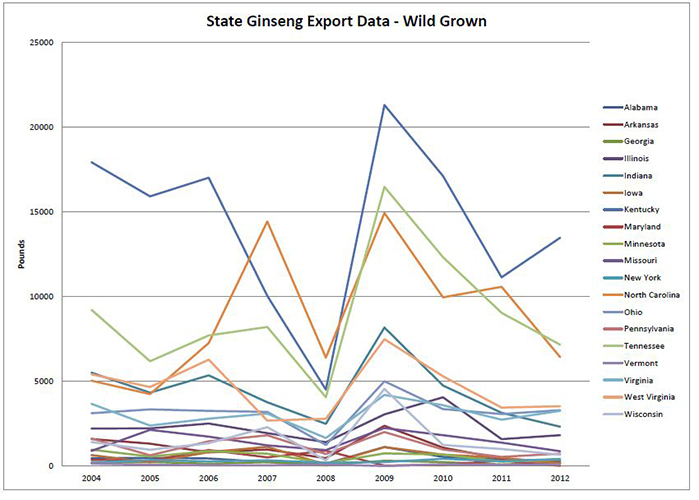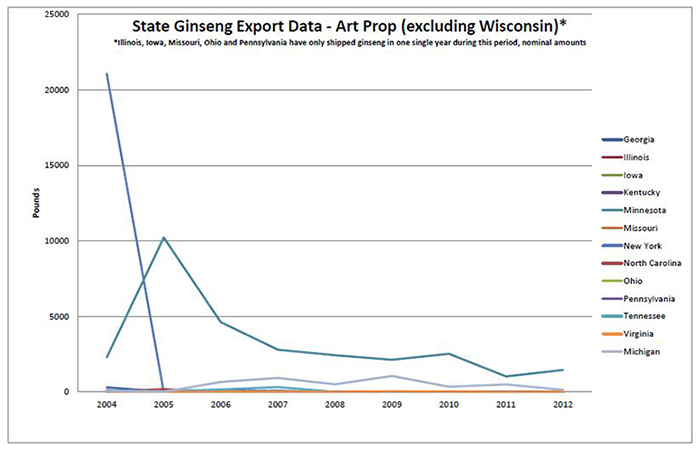|
By Haley Chitty, director of communications, American Herbal
Products Association
Editor’s Note: This article has been revised and expanded from
the original article published in the September 2013 edition of the AHPA Report, the
monthly newsletter of the American Herbal Products Association.1 The
article is reprinted with permission from AHPA.
Four states and five national forests
are taking steps this year to improve their management of the harvest of wild
American ginseng (Panax quinquefolius) in efforts to ensure
sustainability of wild populations. The annual value of wild American ginseng
at the initial point of collection is roughly $27 million, according to
research funded by the American Herbal Products Association’s (AHPA) Education
and Research on Botanicals Foundation.2
American Ginseng and CITES
Wild American ginseng populations face several threats, according to the US
Fish and Wildlife Service (FWS). These threats include loss of habitat due to
urban sprawl, energy development activities
and logging (industry
observers also count mining operations as significant contributors to habitat
loss for ginseng and numerous other woodland plants), competition due to
invasive non-native plant species, overpopulation of deer, and illegal and
irresponsible harvesting.
American ginseng has been listed on Appendix II of the Convention on
International Trade in Endangered Species (CITES) since 1975.3 Appendix
II includes species that are not necessarily threatened with extinction now,
but may become threatened if trade is not closely controlled. International
trade of Appendix II-listed species is authorized only if the relevant CITES
authorities in the country of export determine that export will not be
detrimental to the survival of the species and that the specimens to be
exported were legally obtained. CITES requirements are especially relevant for
wild American ginseng because the vast majority of each year’s harvest is
exported.
The FWS Division of Scientific Authority (DSA) is responsible for making the
required “non-detriment” determination. In recent years, the Division has determined
that the export of wild and wild-simulated ginseng harvested in 19 states is
not detrimental to the survival of the species, as long as harvested plants are
at least five years old.3 Plants that are five years
of age are considered to be reproductive and have produced seeds for
regeneration. FWS annually reviews
these states’ laws and regulations for the harvest and sale of ginseng and
management programs that monitor and protect wild ginseng from overharvest, as
well as current research and other relevant information concerning the status
and trade of ginseng.
In its 2012 findings, FWS indicated its support for Georgia, Pennsylvania,
Vermont, and Virginia to improve their regulation and management of ginseng and
its importance to the non-detriment finding for the 2013 harvest.4
More specifically, FWS encouraged these states to amend their harvest seasons
to begin on September 1, as is required in the other states from which harvest
and export is allowed.
State Regulatory Changes for 2013
Three of these four states have now made regulatory changes in time to
affect the 2013 harvest:
·
Georgia
delayed the start of the ginseng harvest season from August 15 to September 1.5
·
Pennsylvania
postponed the start of the harvest season from August 1 to September 1.6
·
Virginia
changed the opening of the harvest season from August 15 to September 1. The
state also established rules similar to those already in place in other states,
so that harvest is limited to ginseng that is at least five years old with at
least four stem scars on its rhizome or three leaf prongs.7
Although Vermont did not make any changes for the 2013 harvest, the state is
working to enact regulatory amendments that could be implemented as soon as the
2014 season. These changes are proposed to include a new permit fee structure
for ginseng collectors, revise the harvest period to begin on September 1 and
end on October 30 (currently it is from August 20 to October 10), increase the
minimum plant age from five years to 10 years, and extend the period for
certification of green root from October 20 to December 31.8
In addition, Maryland announced earlier this year that it is prohibiting all
wild ginseng harvest in 2013 on state lands managed by the Maryland Department
of Natural Resources.9,10
Harvest Restrictions in National Forests
for 2013
Historically, the US Department of Agriculture National Forests allowed
collection of various woodland plants (e.g., non-timber forest products),
including wild American ginseng, on a permit basis.11 Several of the
National Forests in ginseng’s range have announced new restrictions to limit
the amount of wild ginseng that will be permitted for harvest in the 2013
season:
·
Cherokee
National Forest in Tennessee has limited the 2013 ginseng collecting season to
September 16 to September 30. The Forest Service will issue a total of 40
permits, each with a maximum limit of 25 roots. A lottery will be held to
determine the 40 permittees. Twenty permits will be issued for the northern
half of the forest (Watauga and Unaka ranger districts) and 20 permits will be issued
for the southern half of the forest (Tellico and Ocoee ranger districts).
Permits will cost $20 and are limited to one per person per year. Permittees
must be at least 18 years of age.12
·
Nantahala
and Pisgah National Forests in North Carolina reduced the number of permits by
75% and will issue only 136 permits. The harvest season is reduced from four to
two weeks (September 1 to 15). Permits will be issued through a lottery system
at each district office. A permit allows one-to-three wet pounds of wild
ginseng to be harvested in the district where the permit is issued. In
addition, the Forest Service said it will increase enforcement efforts and
penalties for unlawful ginseng collection.13
·
Chattahoochee
National Forest in Georgia limited the harvest season to September 15 to 28.
The Forest Service will only issue 42 annual permits. Permits will be issued
through a lottery system. A permit allows the harvest of 0.5 wet pound of wild
ginseng in the ranger district where the permit is issued. In addition, the
Forest Service is increasing law enforcement efforts to reduce poaching.14
·
Daniel Boone National Forest in Kentucky limited the harvest season to September 15 to 30. The
Forest Service will issue only 60
permits, for one wet pound of wild ginseng. Permits
will be issued through a lottery system.15
"These changes will help ensure the sustainability of ginseng," FWS
stated in its 2013 non-detriment finding.
Ensuring Sustainability
FWS reported in its 2013 non-detriment
finding that Forest Service and National Park Service officials have increased
enforcement efforts to curtail illegal harvesting. Officials have increased the
marking of wild ginseng roots with permanent markers like colored dyes to
detect illegally harvested roots. The harvest of all wildlife, including
ginseng, on National Park Service lands is strictly prohibited.
FWS also identifies a number of future
actions "to continue to minimize the impact of harvest of ginseng for international
trade." These actions include the following:
- supporting
efforts in Vermont to delay the start of the harvest season until September
1 for the 2014 season;
- exploring
strategies to reduce illegal harvesting;
- investigating
seed collection and the establishment of regional seed banks;
- exploring
the implementation of a standard to convert wet root weight to dry root
weight; and
- investigating
how wild-simulated roots can be reported separately from wild roots in State
annual reports so that the impact of harvests on wild populations and the
status of the species can better be assessed.
AHPA has long been an advocate of good
collection practices to ensure the long-range survival of wild American
ginseng. In 2006, AHPA worked cooperatively with FWS, United Plant Savers, and
the Ohio-based Roots of Appalachia Growers Association to create a brochure for
each of the 19 harvest/export ginseng-range states to provide information on
state regulations and input on best harvest practices. These “Good
Stewardship Harvesting of Wild American Ginseng” brochures are available at no cost
and are regularly updated to stay current with each state’s regulations.
In addition, in support of the recommendations in the FWS 2012 non-detriment
findings, and in earlier findings, AHPA sent letters in 2010 to the appropriate
agencies in Georgia, Kentucky, and Virginia expressing support of new state
rules to improve the management of wild ginseng in these states.16
AHPA noted in these letters that the adoption of these rules, in addition to
those already in place in each state, would create better regulatory
consistency throughout the wild ginseng harvest range and would protect the
continued harvest of wild ginseng.
“The responsible
harvest of wild ginseng from natural forests
has provided substantial income for people living in
economically marginalized regions,” said AHPA President Michael
McGuffin. “Promoting and passing down these
responsible harvesting practices helps ensure the sustainability of wild American
ginseng which helps improve local economies and conserve the biodiversity of Eastern American forests.”
Quick Facts about the 2012 Wild
American Ginseng Harvest
·
22.7
tons of wild and wild-simulated American ginseng were legally exported in 2012;
·
27.5
tons (roughly 13 million plants) of dried wild and wild-simulated roots were
harvested during the 2012 season;
·
There
was a 6% decline in the 2012 wild and wild-simulated ginseng harvest compared
to 2011;
·
Many
states reported that drought impacted the availability of ginseng in 2012.
The following graphs represent ginseng export data from 2004-2012, as calculated by the US Fish and Wildlife Service. Only a few states
distinguish wild simulated ginseng from wild ginseng and some call wild
simulated ginseng "artificially propagated" ginseng—likely due to confusion about the CITES definition of "artificially propagated." These
issues should be considered when viewing the graphs, which are included to illustrate the drastic ups-and-downs in export for both categories.



References
1. Chitty H.
2013 Wild American ginseng harvest. AHPA
Report. September 2013. Silver Spring, MD: American Herbal Products Association.
2. Chamberlain JL, Prisley S, McGuffin M. Understanding the relationships between
American ginseng harvest and hardwood forests inventory and timber harvest to improve
co-management of the forests of Eastern United States. J Sustain Forest. 2013 July 29; 32(6):605-624.
3. General advice for the export of roots of wild and wild-simulated American
ginseng (Panax quinquefolius) legally
harvested during the 2013 harvest season. United States Department
of the Interior: Fish and Wildlife Service. Issued September 5, 2013. Available here. Accessed August 21, 3013.
4. U.S. Department of the Interior Fish and
Wildlife Service CITES nondetriment finding for wild American Ginseng. September
7, 2012. Available here. Accessed August 21, 3013.
6. Ginseng. Pennsylvania
Department of Conservation and Natural Resources website. Available here. Accessed August 21, 2013.
8. Proposed
amendments to the ginseng rules. Vermont Agency of
Agriculture Food & Markets website. Available here. Accessed August 26, 2013.
15. Forest product permits. US Forest
Service Daniel Boone National Forest website. Available here.
Accessed October 3, 2013.
16.
McGuffin M. Re: Harvest of wild ginseng in Georgia. Letter to Trina Morris and
Lisa Kruse, Georgia Department of Natural Resources. September 21, 2010.
Available here.
|